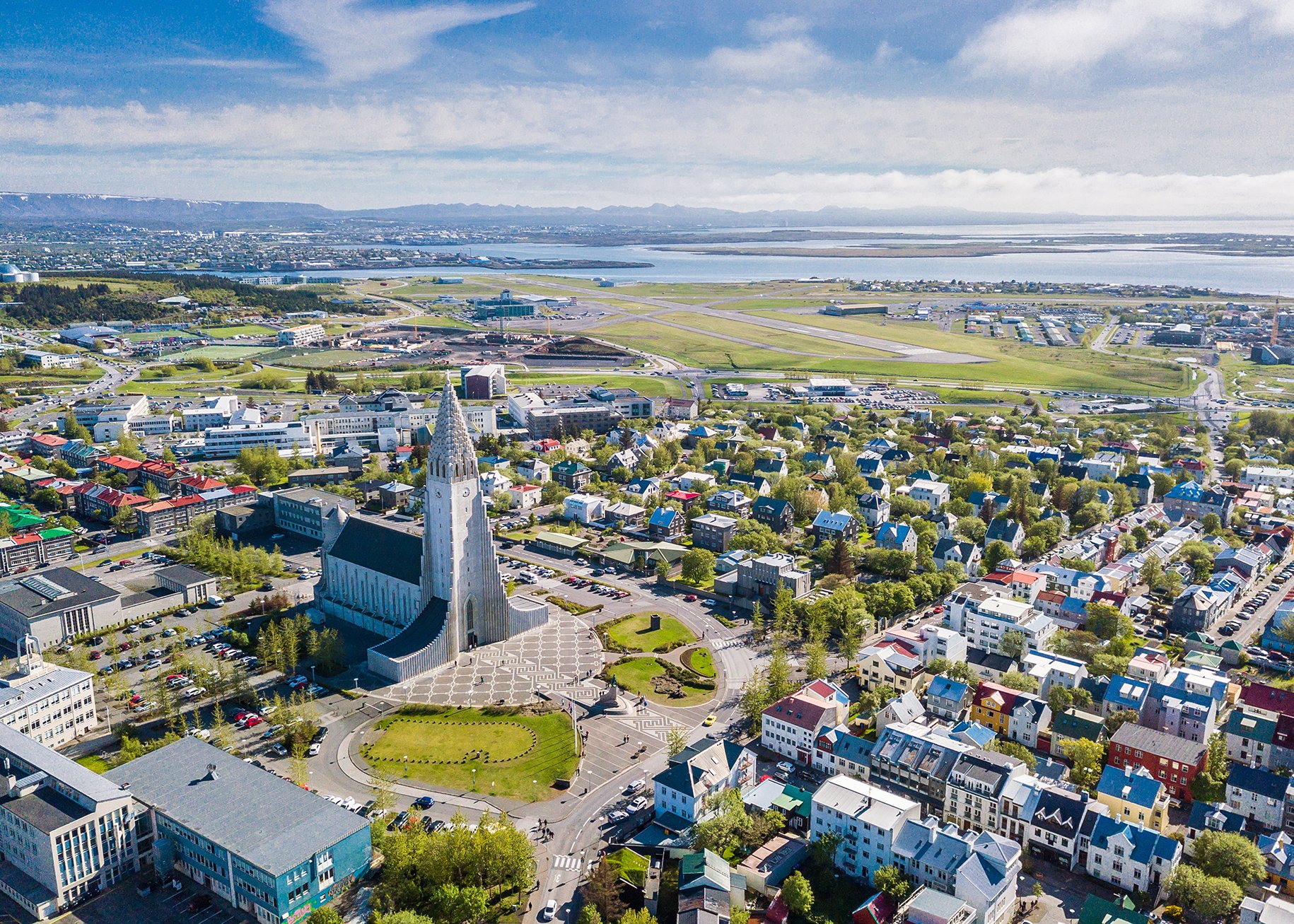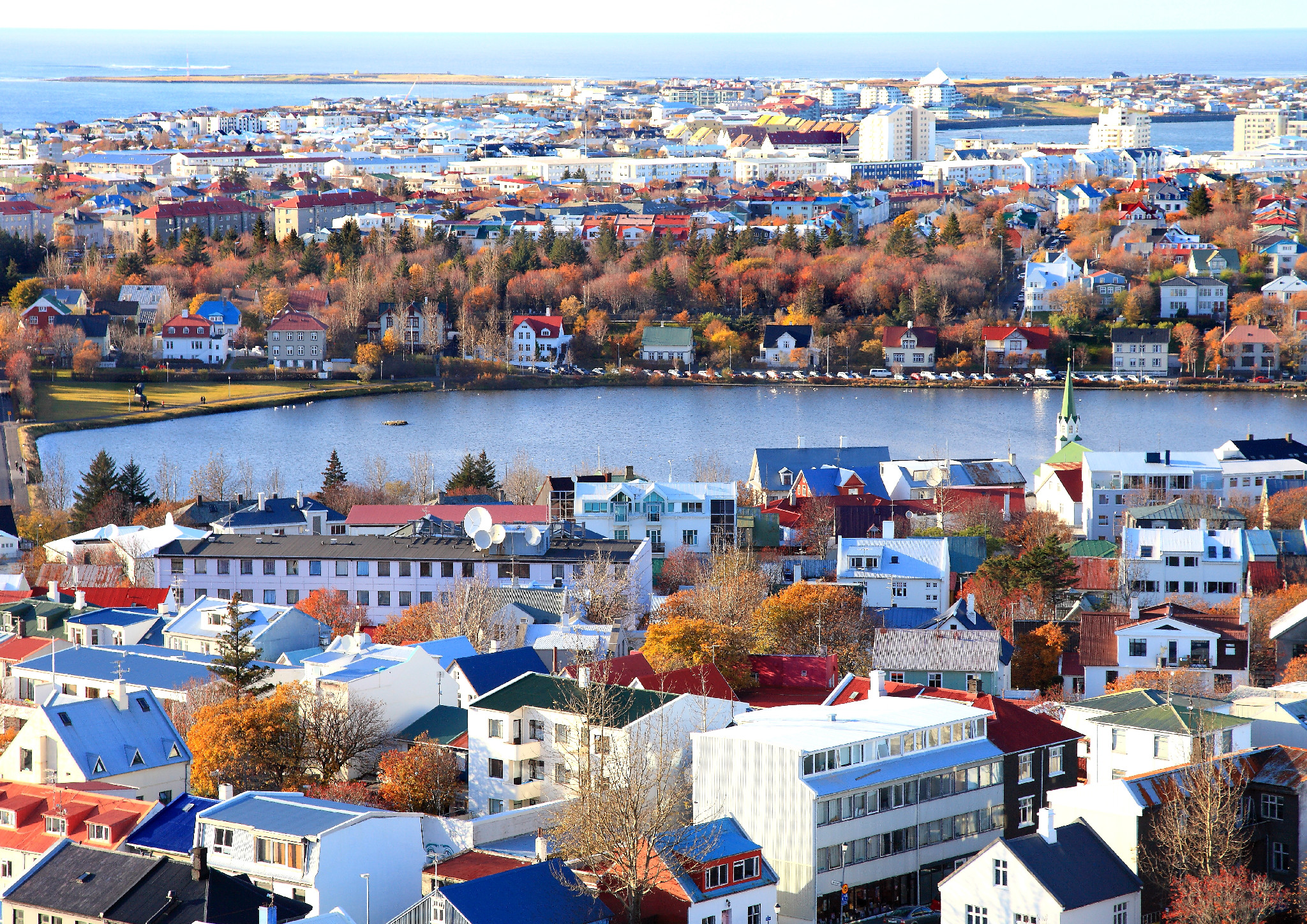(Quelle: Droning Iceland)



Reykjavík [ˈreiːcaˌviːk] ist die Hauptstadt Islands und die am nördlichsten gelegene Hauptstadt der Welt (Breitengrad 64° 08' N, 269 Kilometer südlich des nördlichen Polarkreises). Die Stadt bildet mit einigen ländlichen Gebieten und etlichen Inseln die Gemeinde Reykjavíkurborg (isl. Stadt Reykjavík). Reykjavíkurborg ist die mit Abstand größte Gemeinde in dem weitere sieben Gemeinden umfassenden Gemeindeverband Höfuðborgarsvæðið (wörtl.: das Hauptstadtgebiet oder der Hauptstadtbereich). In diesem dichtbesiedelten Gemeindeverband lebten Ende 2010 insgesamt 202.341 Menschen.[1]
Der Name Reykjavík ist das isländische Wort für „Rauchbucht“; er rührt vermutlich von den Dämpfen der heißen Quellen in der Umgebung, und wird einem Missverständnis des ersten Siedlers Ingólfur Arnarson zugeschrieben. Die Stadt ist die älteste permanente Siedlung des Landes. Obwohl die ersten Siedler bereits im Jahre 870 n. Chr. das Land bevölkerten, wuchs das Gebiet nur sehr langsam und wurde erst 1786 offiziell zur Stadt erhoben.
Reykjavík ist mit 123.246 Einwohnern (Stand: 1. Januar 2017) die größte Stadt Islands; hier wohnen etwa 37,3 % der Gesamtbevölkerung des Landes. In der Metropolregion Reykjavík leben über 200.000 Menschen. Die Stadt liegt am Atlantik, genauer gesagt an der Faxaflói-Bucht unterhalb des etwa 900 Meter hohen Hausberges Esja.
In der Stadt befinden sich die meisten Fakultäten der Universität des Landes und verschiedene andere Hochschulen, Theater, Museen und Kultureinrichtungen sowie ein Hochseehafen. Mitten in der Stadt liegt ein kleiner See namens Tjörnin. Dieser See ist zugleich auch einer der größten Brutplätze für Wasservögel im Südwesten von Island.
雷克雅未克(冰岛语:Reykjavík,冰岛语音标: [ˈreiːkjaˌviːk] ![]() 聆听)位于法赫萨湾南部,是斯堪的纳维亚北欧岛国冰岛的首都,亦是冰岛最大的城市。雷克雅未克地理上非常接近北极圈,其纬度64°08'N,是全世界最北的首都。是全世界(北欧)市容最干净无烟城、全靠地热能的首都圈。在2012年,雷克雅未克人口大概为120,000人(大雷克雅未克区人口则超过200,000人),是全冰岛的文化、经济和政务活动中心。
聆听)位于法赫萨湾南部,是斯堪的纳维亚北欧岛国冰岛的首都,亦是冰岛最大的城市。雷克雅未克地理上非常接近北极圈,其纬度64°08'N,是全世界最北的首都。是全世界(北欧)市容最干净无烟城、全靠地热能的首都圈。在2012年,雷克雅未克人口大概为120,000人(大雷克雅未克区人口则超过200,000人),是全冰岛的文化、经济和政务活动中心。
雷克雅未克曾被丹麦及挪威管治过,亦在其管治期间发展了本地的经济及产业,故此,于冰岛独立成主权国家时,该城便被立为首都。现时,冰岛议会大厅、政府大楼、国家博物馆等设施都设立于雷克雅未克。
レイキャヴィーク[2](Reykjavík アイスランド語発音: [ˈreiːcaˌviːk] (![]() 音声ファイル))は、アイスランドの首都。
音声ファイル))は、アイスランドの首都。
アイスランド島南西部のレイキャネース半島の根元に位置し、ファクサ湾に面する港湾都市である。首都としては世界最北の北緯64度8分に位置する。市名は「煙たなびく湾」という意味で、最初の上陸者が近郊の温泉から上る湯煙を炎の煙と見間違えて名づけた地名と言われている。
人口は市内のみで約12万人、周囲の市を含めた首都圏全体で約21万人である。アイスランドの全人口の約2/3がこの一帯に集中している。
近海は南方からの暖流と北極方向からの寒流とがぶつかる潮目が存在している関係で世界有数の好漁場となっており、古くから水産業が産業の根幹を占めてきた。ただし、近年は水産業依存からの脱却を図っており、低い所得税率、ヨーロッパとアメリカの中間という地理条件、充実したインフラストラクチャー網を活かして外国資本の積極誘致を行っている。
市内の暖房・給湯システムは地熱の熱エネルギーのみで維持されており、自然エネルギーとの共存が図られている。他にも燃料電池自動車に水素を供給する水素ステーションを建設し、それを利用した路線バスを世界で初めて運行するなど、クリーンエネルギー政策の点では世界をリードしている。
市内では犬を飼うことが法律で禁止されているが、申請することで飼うことができる。また、世界で最も人口1人当たりの書店の密度が高い町と住民は自称している。
世界的な義肢メーカーのオズール(Össur)が本社を置いている。
Reykjavík (/ˈreɪkjəvɪk, -viːk/ RAYK-yə-vik, -veek; Icelandic: [ˈreiːcaˌviːk] (![]() listen))[4][5] is the capital and largest city of Iceland. It is located in southwestern Iceland, on the southern shore of Faxa Bay. Its latitude is 64°08' N, making it the world's northernmost capital of a sovereign state. With a population of around 123,300 (and over 216,940 in the Capital Region),[3] it is the heart of Iceland's cultural, economic and governmental activity, and is a popular tourist destination.[6]
listen))[4][5] is the capital and largest city of Iceland. It is located in southwestern Iceland, on the southern shore of Faxa Bay. Its latitude is 64°08' N, making it the world's northernmost capital of a sovereign state. With a population of around 123,300 (and over 216,940 in the Capital Region),[3] it is the heart of Iceland's cultural, economic and governmental activity, and is a popular tourist destination.[6]
Reykjavík is believed to be the location of the first permanent settlement in Iceland, which, according to Ingólfr Arnarson, was established in AD 874. Until the 19th century, there was no urban development in the city location. The city was founded in 1786 as an official trading town and grew steadily over the following decades, as it transformed into a regional and later national centre of commerce, population, and governmental activities. It is among the cleanest, greenest, and safest cities in the world.[7][8][9]
Reykjavik (en islandais Reykjavík [ˈreiːcaˌviːk], littéralement « Baie-des-Fumées ») est la capitale de l'Islande. Elle se situe à environ 250 km au sud du cercle polaire arctique, ce qui en fait la capitale la plus septentrionale d'un État souverain (la capitale du Groenland, Nuuk, étant située quelques kilomètres plus au nord). Elle s'étale entre deux fjords, dans une zone comptant de nombreuses sources chaudes, le long d'une baie (vik en islandais). Elle est ainsi considérée comme la ville la "plus verte du monde" : on y compte environ 410 m² d'espaces verts par habitant.1
C'est la ville la plus peuplée du pays, avec environ 120 000 habitants. Avec l'agglomération, elle regroupe pratiquement les deux tiers de la population de l'île, soit environ 200 000 habitants.
Son emplacement se situe à l'endroit même où s'installèrent en 874 les premiers colons conduits par Ingólfur Arnarson. Un groupement de 302 habitants ayant eu lieu en 1786 est à l'origine de la municipalité d'aujourd'hui.
C'est à Reykjavik que sont concentrées les activités politiques, industrielles, commerciales, et culturelles du pays.
Reykjavík (pronuncia IPA: [ˈreɪcaviːk]) è la capitale e principale città d'Islanda. Con circa 120.000 abitanti è il cuore politico, culturale ed economico dell'isola. Vi si trovano le maggiori facoltà universitarie del paese, teatri, musei e istituzioni culturali ed i principali servizi caratteristici di una capitale occidentale. Forma con altre città un conglomerato urbano di circa 206.000 abitanti, ovvero 2/3 dell'intera popolazione islandese (circa 320.000 abitanti).
Si crede che Reykjavík sia stato il primo insediamento permanente dell'isola. La sua fondazione avvenne ad opera di Ingólfur Arnarson intorno all'anno 870. Il significato islandese del nome, in italiano, può essere tradotto in baia fumosa e fu scelto dal fondatore per via dei fumi geotermali che circondano la zona. Lo sviluppo urbano, dalle precedenti fattorie, incominciò solo nel XVIII secolo.
Reikiavik2 (en islandés Reykjavík ![]() /ˈreiːcaˌviːk/ (?·i), «bahía humeante»;3 oficialmente en islandés Reykjavíkurborg, «Ciudad de Reikiavik») es la capital y ciudad más poblada de Islandia. Situada al sur de la bahía Faxaflói, en una zona donde abundan los géiseres, su latitud es de 64º 08' N, muy cerca del círculo polar ártico, lo que la convierte en la capital más septentrional de un Estado soberano. Durante el invierno solo recibe cuatro horas diarias de luz solar y durante el verano las noches son tan claras como el día.
/ˈreiːcaˌviːk/ (?·i), «bahía humeante»;3 oficialmente en islandés Reykjavíkurborg, «Ciudad de Reikiavik») es la capital y ciudad más poblada de Islandia. Situada al sur de la bahía Faxaflói, en una zona donde abundan los géiseres, su latitud es de 64º 08' N, muy cerca del círculo polar ártico, lo que la convierte en la capital más septentrional de un Estado soberano. Durante el invierno solo recibe cuatro horas diarias de luz solar y durante el verano las noches son tan claras como el día.
Su población es de 121 960 habitantes (2015),1 un tercio de la del país. El distrito de la capital alcanza los 212 120 habitantes.1 Es una de las ciudades más limpias, verdes y seguras del mundo.456
Рейкья́вик[2] (исл. Reykjavík, [ˈreiːcaˌviːk] ![]() слушать; в буквальном переводе означает «дымящаяся бухта») — столица и крупнейший город, а также община Исландии. Население — 118 814 жителей (2012), а включая города-спутники — около 202 000, что составляет около 63 % всего населения страны (321 857). Это самая северная в мире столица государства. Рейкьявик расположен в юго-западной части острова, на полуострове Сельтьяднарнес. Город расположен в зоне сдвига тектонических плит, поэтому для него характерны небольшие землетрясения. Через Рейкьявик протекает река Эдлидаау. Она не судоходна, однако богата рыбой. Так как город находится недалеко от полярного круга, для него характерны очень светлые белые ночи летом и очень короткий (около 4 часов) световой день зимой.
слушать; в буквальном переводе означает «дымящаяся бухта») — столица и крупнейший город, а также община Исландии. Население — 118 814 жителей (2012), а включая города-спутники — около 202 000, что составляет около 63 % всего населения страны (321 857). Это самая северная в мире столица государства. Рейкьявик расположен в юго-западной части острова, на полуострове Сельтьяднарнес. Город расположен в зоне сдвига тектонических плит, поэтому для него характерны небольшие землетрясения. Через Рейкьявик протекает река Эдлидаау. Она не судоходна, однако богата рыбой. Так как город находится недалеко от полярного круга, для него характерны очень светлые белые ночи летом и очень короткий (около 4 часов) световой день зимой.












